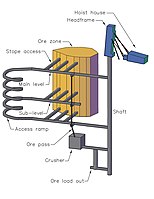
Photo from wikipedia
To investigate the physicomechanical properties of stope backfill and to explore the mining conditions for an adjacent pillar, four boreholes, namely, GZK1, GZK2, GZK3, and GZK4, were constructed for taking… Click to show full abstract
To investigate the physicomechanical properties of stope backfill and to explore the mining conditions for an adjacent pillar, four boreholes, namely, GZK1, GZK2, GZK3, and GZK4, were constructed for taking the backfill core in the test stope. During borehole sampling, it is found that the strength of backfill is usually lower than that of the rock and ordinary concrete, and its resistance to tensile and compressive loads is limited. Therefore, the drilling speed should not be too fast, and a small amount of water is needed to continue drilling smoothly. For backfill with high strength, the sampling process is relatively smooth, and the backfill samples are relatively complete. GZK1 is located on the upper part of the stope near the footwall of the orebody, and the test results show that the backfill quality of this part is poor; thus, a complete backfill core cannot be obtained. GZK2 is located at the bottom of the stope close to the footwall of the orebody, GZK3 is located at the bottom of the stope close to the hanging wall of the orebody, and GZK4 is located at the top of the stope close to the hanging wall of the orebody. The average compressive strength and average tensile strength of the backfill samples obtained from the three boreholes, namely, GZK2, GZK3, and GZK4, are 2.928 to 3.583 MPa and 0.328 to 0.523 MPa, respectively, indicating that the backfill near the upper part and bottom close to the hanging wall of the orebody is good, while the backfill near the upper part close to the footwall of the orebody is poor. Special attention should be paid to the backfill with the range of GZK1 in the future second-step pillar mining process, and the sublevel method can be adopted to ensure the safety of the mining process. The backfill samples in the large goaf of No.17 room were obtained by geological drilling. Segregation occurred in the upper part of the No.17 room near the area of the footwall. The concentration and flow rate of the filling slurry were reasonably adjusted and controlled with the improvement of backfill quality. Therefore, the backfill strength of the No.17 room is generally good, which can meet the requirements of pillar mining, and also creates a good condition for the resource utilization of waste tailings of Caolou Iron Mine.
Journal Title: Geofluids
Year Published: 2021
Link to full text (if available)
Share on Social Media: Sign Up to like & get
recommendations!